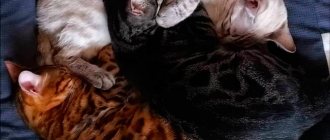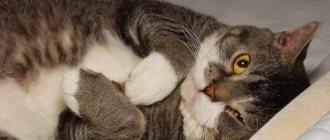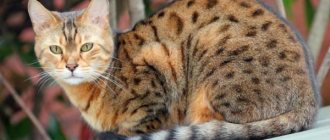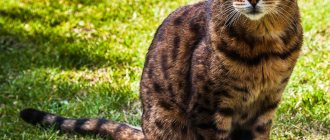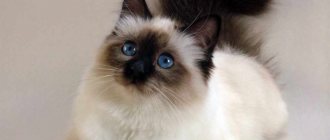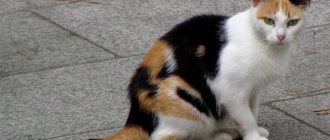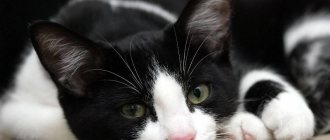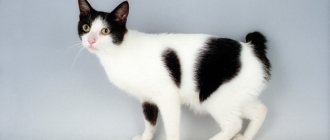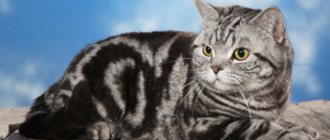History of the discovery of the species
The classification of the genus of wild eastern cats (Prionailurus) began in 1858. There are 5 species in this genus, one of them is Bengal. Numerous of its representatives live in Asia. The name was given after the area where Europeans first saw them - Bengal in India.
There were also some interesting legends. According to the Indian, the Asian leopard was inflamed with love for the cat, as a result of which this amazing beautiful animal appeared. This explains another well-known name: Asian leopard. The Bengal cat species is widespread and has 11 subspecies, differing in appearance and area of distribution. This explains the existence of many other names: dwarf, Indian, Far Eastern cat, Javanese, coin, Chinese, etc.
You may be interested in: article about the colors of the Bengal cat breed.
Mr. Cat recommends: description, characteristics, habitat
In nature, wild cats are found on islands in Indonesia, the Amur region, and Asia, where they are represented by numerous subspecies. They adapt well to different conditions: forests, plains, taiga. They prefer places near water sources, but away from human settlements. Avoid desert areas without vegetation. They are found in the mountains at an altitude of 3 thousand m above sea level, on rocks and rocky outcrops.
The color and pattern on it changes depending on the habitat. The main color tone is shades from yellow to gray-brown. The chin, chest, and belly are almost white, and the end of the tail is black. Dark spots are scattered throughout the body: circles, smears, or collected in rosettes. The drawing can stand out strongly against the background or be almost invisible.
The length of the elegant strong body is 75-100 cm, the tail is almost half, the height is 39-41 cm. Weight is 3.8-7 kg. Males are larger than females. The coat is thick, soft, and short. The head is small in size with a narrow muzzle. The ears are rounded without tufts. The eyes are brown, large and round. The tail looks like a carrot.
They live in nature for 12-15 years. The voice resembles that of a domestic cat.
Description of the breed
Bengal cat standard
- Body : massive, muscular. The neck looks proportional to the parts of the body, muscular. The height of Bengals varies from 33 to 37 centimeters. Weight: up to 4 kg for females and up to 8 kg for males.
- Head: has a wedge shape, which greatly affects the fit of the ears; The muzzles are massive, this gives cats and female cats of this breed a similarity to related “tiger” ones.
- Ears: Set high, rounded, wide at the base.
- Nose: large, has a characteristic curve.
- Eyes: almond shape; green, gold or blue.
- Paws: Muscular, round paws, hind paws longer than front paws.
- Wool: soft, smooth; color similar to a leopard, spots evenly distributed throughout the coat. The main shades of wool: silver, gray, blue-gray, white, red, brown and black. The most popular color is rosette on gold.
There is a special distribution of the pattern on the wool:
- Stains.
- Marble.
Types of rosettes in Bengal cats:
- donut;
- chain sockets;
- clusters of rosettes;
- paws;
- smoky rosettes;
- Arrowhead.
Colors of Bengal cats with photos:
- Golden color with chocolate spots (brown, brown).
- Silver.
- Snowy (links, sepia, mink).
- Blue.
- Coal.
Interesting fact! Snow Bengals are born white, with no spots or patterns on their coats.
Features of behavior
Bengal wild cats are loners by nature. They unite in pairs only for procreation. Active life begins at dusk and lasts throughout the night. They spend the day in hiding. Hollows or roots of trees, caves, and holes abandoned by other animals serve as lairs. Some individuals can hunt during the day, but this is extremely rare.
They climb and swim well. They move quickly through trees thanks to their sharp claws. They set up an ambush on hanging branches and rush at their prey from above. Their body color helps them camouflage well. They mark their territory with urine and excrement. They can relieve their natural needs in water. This helps them hide their presence from potential enemies.
Diet
The main diet of the Bengal cat is rodents (mice, hamsters and rats). Sometimes they hunt other animals that they can defeat: squirrels, hares, birds. They will not refuse captured amphibians, reptiles, and insects. They will eat the eggs if they find them. They can fish, but prefer to hunt on land. The Bengal cat will not play with its prey. She holds it in her teeth until it dies. The remains are hidden in a secret place.
Bengal cat personality
The Bengal cat has a rather complex character. A representative of the breed can be described in the following words:
- smart;
- active;
- curious;
- wayward;
- requiring attention.
These pets will bring the owner many happy moments. But Bengals are not for everyone. A person who has decided to have a pet for the first time will find it difficult to cope with an active, wayward individual.
Cats sleep about 16-20 hours a day. They spend the remaining time playing, eating and getting ready. Representatives of some breeds easily cope with loneliness, being content with the available entertainment. But not Bengal cats, whose nature requires constant company. If your pet is left alone on weekdays, you should get him a companion. This does not have to be a second Bengal cat; the characteristics of the breed include high cost.
Members of the species usually get along well with other animals, including dogs. Bengalis are tolerant of children. But a cat living in a house with kids needs reliable shelter. After resting in the shelter, the pet will again be able to communicate with the child.
Having begun to wonder what a Bengal cat might be like, a description of the breed, the future owner of the animal learns that this species loves to climb to the top. All mousecatchers are prone to exploring cabinets to varying degrees. But Bengals, thanks to their muscular body and strong paws, can easily climb into hard-to-reach places.
Most mousecatchers are afraid of water. But in the answers to the question, Bengal cat, description of the breed, you can see that this species loves to swim. The pet will readily follow the owner into the shower and try to climb into the bath. When you decide to get a pet, you should take into account the threat a Bengal cat poses to the existing inhabitants; the size and weight of an adult animal allow it to climb onto the aquarium. Given its tolerant attitude towards water, the animal will not be afraid of falling into a container without a lid.
If the aquarium is partially closed, the Bengal can create a fishing spot in the feeding area. In both cases, the owner will have to regularly wipe the floor and, if the cat is lucky, replenish the population of the aquarium.
Mousers love to play pranks. Answering the question: the characteristics of the Bengal cat are that it is worth noting its thievery. Given the opportunity, the pet will steal:
- keys;
- decoration;
- memory card in a bright case.
The animal will carry away the object it likes in its teeth or drive it into a shelter with its paws. Answering the question: Bengal cat characteristics of the breed - experts also note destructive behavior. The pet can:
- press switches;
- turn the taps;
- remove plugs from bathtubs and sinks;
- “play” with the remote control and buttons on the equipment.
The mousetrap resorts to such pranks due to lack of attention. The owner needs to think about the Bengal's entertainment in order to avoid unexpected incidents, such as finding car keys in the tray.
Features of caring for Bengals
As is clear from the above, the Bengal cat breed has a wayward character. For a person who has decided to get an animal for the first time, it is better to choose a calmer companion. An experienced cat lover will be able to cope with a “little leopard” more easily. From a hygiene point of view, the pet requires little attention from the owner. Due to the short coat, the Bengal can be combed once every 1-2 weeks. A Bengal does not require bathing. While at home, the animal takes care of its own hygiene.
It is not recommended to let your pet outside unattended. Studying the answers to the request, Bengal cat description of breed and character, the user may notice two features: high cost and curiosity. A kitten on foreign markets costs an average of $1,500. The price depends on the pedigree and the seller.
The characteristic color will allow an attacker to easily distinguish a valuable pet from an ordinary short-haired cat. Even in a closed yard, a Bengal is not immune from clashes with street animals. This breed is characterized by high intelligence. Bengal cats are easy to train using a clicker. But this does not mean that a trained pet will not chase the bird, jumping out of the area. It is worth organizing a comfortable environment for the Bengal indoors or a covered enclosure in the yard.
Given the high level of intelligence, pets easily get accustomed to the tray and toilet. If a toilet is chosen at an early age, it is worth considering how long the Bengal cat will use it; the size and weight of an adult animal affect the characteristics of the container. It is better to accustom the kitten to one bowl (tray), which will not have to be changed for the next few years.
Nutrition for Bengal cats
Like other purebred pets, the animal requires a high-quality diet. When basing your diet on ready-made food, you should choose premium products, such as:
- Hills;
- Brit;
- Royal Canin.
These are common brands. Foreign sources offer less familiar brands like Nom Nom or Weruva. The products are designed to provide the cat with the necessary amount of nutrients.
The owner can opt for a homemade diet. The Bengal cat, which is the size of a regular house mouse, needs protein food. Prepared foods often contain large amounts of carbohydrates. Their share in the cat's diet should be limited. The following dietary meats are suitable for Bengals:
- beef;
- chicken;
- turkey;
- young lamb.
It is advisable to subject food to minimal heat treatment. Some owners feed their cats raw meat. Although this is true to natural conditions, it is best to boil the pieces for at least 3-5 minutes to kill potential pathogens. Once a week, Bengal cats are advised to give fish. The diet may include vegetables (up to 30-40%). But you need to avoid:
- avocado;
- potatoes (regular and sweet);
- fresh eggs;
- wheat and its derivatives (flour, semolina).
Like other cats, Bengals are contraindicated onions, garlic, chocolate and nightshades. These products contain substances that are toxic to the animal's body. Considering that curiosity will be the main trait when answering the question, Bengal cats have a personality trait, it is worth keeping “treats” out of reach. Interested in a new smell, a pet can fish out a green layer of boiled potatoes from the garbage or try a half-raw tomato on a steak.
Possible health problems
When studying the characteristics of Bengal cats, it is important to learn about the health problems characteristic of the breed. Due to the diversity of genetic material, the species is relatively healthy. But, like other breeds, the Bengal cat has a tendency to certain pathologies:
- Distal neuropathy. Pathology of the central nervous system causing weakness. It appears in Bengals older than 12 months. Cats often recover on their own, but relapses of the disease are possible.
- Hip dysplasia.
- Kitten flat chest syndrome. The deformity is caused by a collapsed lung. Silence or a weak cry of a newborn kitten will indicate problems with the respiratory system. SPH occurs with varying degrees of severity. If a kitten survives the disease, it does not appear in adulthood.
- Hypertrophic cardiomyopathy is a hereditary heart pathology.
- Progressive retinal atrophy.
Interested in what a Bengal cat is like, the characteristics and characteristics of the breed, the future owner learns that the species is predisposed to certain infectious diseases. Animals are susceptible to peritonitis pathogens and protozoal parasites. To combat genetic pathologies, breeders stop using carriers of defective structures in breeding. To protect against infections, breeders resort to vaccinations and promptly take their pets for a routine examination by a veterinarian.
Interesting facts about Bengalis
When considering the question of a Bengal cat's description of the breed, character often comes in second place. The main interest is the cost of the pet. Bengals are dear companions. In the 90s, according to rumors, one British woman paid $50,000 for her pet, calling him a Rolls Royce.
Brown is the main coat color of the breed. But the selection process gave the Bengalis a “sparkling” gene. The fur of its wearers shimmers beautifully in the light. In addition to their love of water, Bengal cats differ from their relatives in their tolerant attitude towards harnesses. They calmly (some willingly) allow you to put a leash on them. This attitude allows you to safely satisfy your pet's interest in the outdoors.
The breed is considered quite talkative. Bengalis are not as “eloquent” as Siamese. But, if they want something, they will persistently express their desires to the person. It is important for the owner to understand the pet if he wants to return to a calm life.
Bengals are attached to their owner and strive to spend time with him. They treat strangers differently. Like any pet, a Bengal cat may recognize one guest and avoid another. Representatives of the breed combine the advantages of wild and domestic ancestors. The species combined intelligence, athleticism, ability to adapt and learn.
This is the most necessary information about the Bengal cat breed for those who want to get such a pet. Remember it, or better yet, save it in your bookmarks.
Puberty and reproduction
Puberty in a wild Bengal cat occurs at 1.5 years. To raise offspring, these cats unite in pairs. The female looks for a safe place for the den and arranges it. In the southern regions, mating is possible at any time, in cold regions - in the spring, when it gets warmer and conditions become favorable for raising kittens.
The gestation period is on average 66 days, after which 2-3 kittens are born, less often - 4. They begin to see at 10 days, and within a month they already leave the shelter and begin to get acquainted with the surroundings. They are fed milk; from three weeks of age they are accustomed to eating meat. Both parents are involved in raising the younger generation. Kittens leave them 10 months after birth.
Captivity
It is difficult to tame a wild Bengal cat older than 3 months. To keep it you definitely need a spacious and equipped enclosure. Babies can become tame if they are fed from birth by a person or a domestic cat. At the onset of puberty, sometimes their character deteriorates, so they are castrated at 6.5-10 months.
The wild Bengal cat serves as a breeder of hybrid kittens. To do this, it is crossed with domestic pets. They are easier to keep, but they also create problems for the owner: they spoil things, steal everything and are poorly trained in the litter box. These cats love affection and attention. They are curious and playful by nature. If they feel danger, they won’t go anywhere. They become very attached to their owner and miss him.
Bengal cat
They express their devotion to a person by accompanying him, running on his heels. They can happily take a bath with their owner. This breed should not be kept indoors if the animal will be left alone for a long time. The cat will feel unhappy and become wild and distrustful.
History of the origin of the breed
In 1961, genetic biologist Jean Mill went on a business trip to Bangkok. At a local market, she saw small Far Eastern Bengal kittens that were being sold as an unusual living souvenir. This breed was on the verge of extinction, as poachers hunted for their skin. Jean decided to buy a cat and take her with her to the USA.
Thus began various crossings of the Malaysian wild cat with domestic cats, which led to the formation of a new breed. It is worth noting that on the way to obtaining the result that we can see now, there were a lot of failures, accompanied by the death of kittens.
In 1963, the first hybrid cat Kin-Kin was born. Due to problems in her personal life, Jean stopped working with the breed. Malaysia was given to a zoo, and Kin-Kin died of pneumonia.
15 years later, Mill continued to work on the breed, because it turned out that some wild cats are immune to the feline leukemia virus. In breeding work, wild Bengal cats from India were used to obtain beautiful rosettes on the coat and preserve the characteristic shine of the outer hair - glitter. It was only in the 80s that the breed was officially registered, and in the 90s Bengals were allowed to participate in competitions and exhibitions under the TICA system. Thanks to the color and quality of their fur, cats have won the hearts of many felinological systems.
Due to the large amount of mixing of genes from other breeds, the long-hair gene sometimes wakes up . Such cats are not allowed to show, but they attract interest from breeders and are called silk or cashmere bengals.
